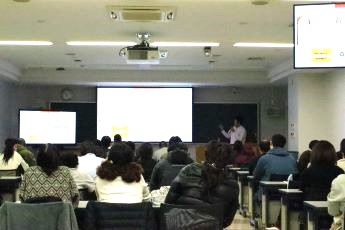- Home
- プログラム生/Ally生の活動報告
- 第15回 Student Monthly Progressを開催しました
第15回 Student Monthly Progressを開催しました
10月25日 (金)、第15回 Student Monthly Progressを開催し、3名の大学院生が自身の研究内容について発表を行いました。
【発表者】
1. MUSONDA Richard:Division of Bioinformatics
<Clustering SARS-CoV-2 variants using relative instantaneous reproduction numbers>
2. LAWAL Maryam Sani:Division of Collaboration and Education
<Upscaling Viral Infectious Disease Monitoring and Surveillance with Metagenomic Next Generation Sequencing Enhanced by a Group Testing Algorithm (mEGA)>
3. XU Shucheng:Laboratory of Biochemistry
<Neurotrophin-3 regulates the proliferation of pre-adipocytes in mice>
【座長】
TAN Joshaniel Yong Yin:Laboratory of Wildlife Biology and Medicine
CHIJIKWA Jeremiah Buumba:Laboratory of Theriogenology

❖座長レポート❖
Clustering SARS-CoV-2 variants using relative instantaneous reproduction numbers
MUSONDA Richard

Since the severe acute respiratory syndrome coronavirus 2 (SARS-CoV-2) was first reported in 2019, the virus has continuously evolved by accumulating mutations. As of October 2024, a total of 4,263 SARS-COV-2 variants were registered in the pangolin database. It has been observed that the variants with the highest reproductive numbers become the dominant strains over time through natural selection. In his previous study, they developed a model of variant replacement using relative instantaneous reproduction numbers (with respect to (w.r.t) a baseline variant. When multiple variants circulate simultaneously, it becomes difficult for humans to understand the dynamics of variant replacement. To simplify the variant replacement model, they introduce a method to find clusters of variants that share the same, aiming to give meaningful information about circulating variants. In his modeling, he was able to find a model that reduced 46 variants down to 26 clusters with a more ideal AIC value. The total computation time was about 8 hours, indicating that the algorithm can find a good model in a reasonable amount of computational time. In this model, variant KP.3.1.1 had the highest relative instantaneous reproduction number with a value of 1.43 and no variants are clustered together with KP.3.1.1, indicating that it is a unique variant that will be the major variant in the USA. In conclusion, this method can reduce the complexity of the model by clustering variants, and it allows for focus on groups of variants rather than individual variants, making interpretation easier.
Upscaling Viral Infectious Disease Monitoring and Surveillance with Metagenomic Next Generation Sequencing Enhanced by a Group Testing Algorithm (mEGA)
LAWAL Maryam Sani

Metagenomic next-generation sequencing (mNGS) has revolutionized infectious disease detection by providing an unbiased approach to identifying pathogens without prior knowledge. This has greatly enhanced clinical diagnostics and the ability to respond to potential disease outbreaks. However, despite its transformative potential, the high cost of mNGS poses a significant barrier to its widespread adoption in routine public health practices, particularly in low-income regions where zoonotic and reemerging infections are most prevalent. Her study addresses this challenge by introducing an innovative approach, mNGS Enhanced by a Group Testing Algorithm (mEGA), which significantly reduces costs while maintaining the accuracy and efficiency of viral pathogen detection. This study aims to optimize metagenomic next-generation sequencing (mNGS) using the mEGA method to improve cost-efficiency by compressing samples from 2ⁿ to 2n while maintaining traceability to original samples. It also seeks to validate mEGA's scalability for large-scale disease surveillance. The mEGA method successfully identified multiple viral pathogens of significant public health concern in pooled samples: Lassa, Measles, Hepatitis B, and Human Parvovirus B19. Validation of mEGA results was conducted using viral-specific qPCR, confirming the presence of these viruses in their respective pools. Notably, the Lassa virus genome detected was only 81.022% similar to the reference sequence. Her study demonstrates that mNGS Enhanced by a Group Testing Algorithm (mEGA) is a powerful tool for cost-effective, scalable viral disease surveillance. The method not only reduces the number of sequencing libraries required but also retains the ability to trace pathogens to their original samples, even in complex pooling setups. mEGA holds great promise for large-scale monitoring of viral pathogens, making it a practical solution for pandemic preparedness, public health surveillance, and One Health applications across human, animal, and environmental sectors.
Neurotrophin-3 regulates the proliferation of pre-adipocytes in mice
XU Shucheng

Adipose tissue is responsible for storing energy and producing heat to maintain body temperature. It also secretes leptin, resistin, TNFα, and other substances that help regulate the body's energy balance and metabolism. Excessive accumulation of fat leads to obesity, which causes metabolic disturbances in the body, and abnormalities in adipocyte function are likely to play a role in the development and progression of type 2 diabetes mellitus. There are two types of adipose tissues – white adipose tissue is mainly involved in energy storage, while brown adipose tissue is specialized for thermogenesis. There is also a very specialized cell type called beige adipose cell, it represents a transitional form of white adipose cell that can be thermogenic under specific conditions. Neurotrophin-3 (NT-3), a member of the neurotrophic family, plays a pivotal role in the nervous system development and maintenance through a receptor called Tropomyosin receptor kinase C (Trk C). It has been reported that NT-3 is expressed in adipose tissue and induces beige adipocytes through the activation of sympathetic nerve innervation. The objective of Shucheng’s study was to elucidate the role of NT-3 in pre-adipocyte proliferation. RT-PCR analysis indicated the expression of NT-3 in all adipose tissues, whereas the expression of TrkC was high in BAT and low in both iWAT and gWAT. Cell proliferation was decreased by NT-3 neutralizing antibody, suggesting that NT-3 has a regulatory role in pre-adipocyte. NT-3 expression was observed in a population of non-adipocytes characterized by the expression of Pdgfra but not Adipoq. TrkC expression was observed in the brown adipocyte population expressing Ucp1 and Adipoq.l. These results suggest that NT-3 regulates not only the proliferation of pre-adipocytes but also the function of brown adipocytes.




